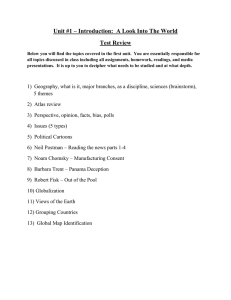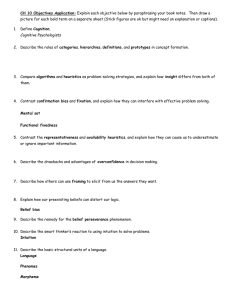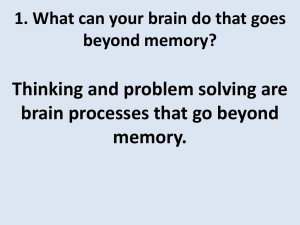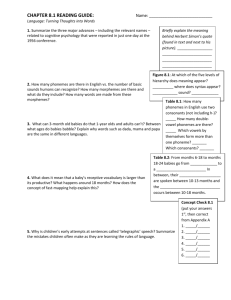Language: Phonemes: Morphemes:
advertisement
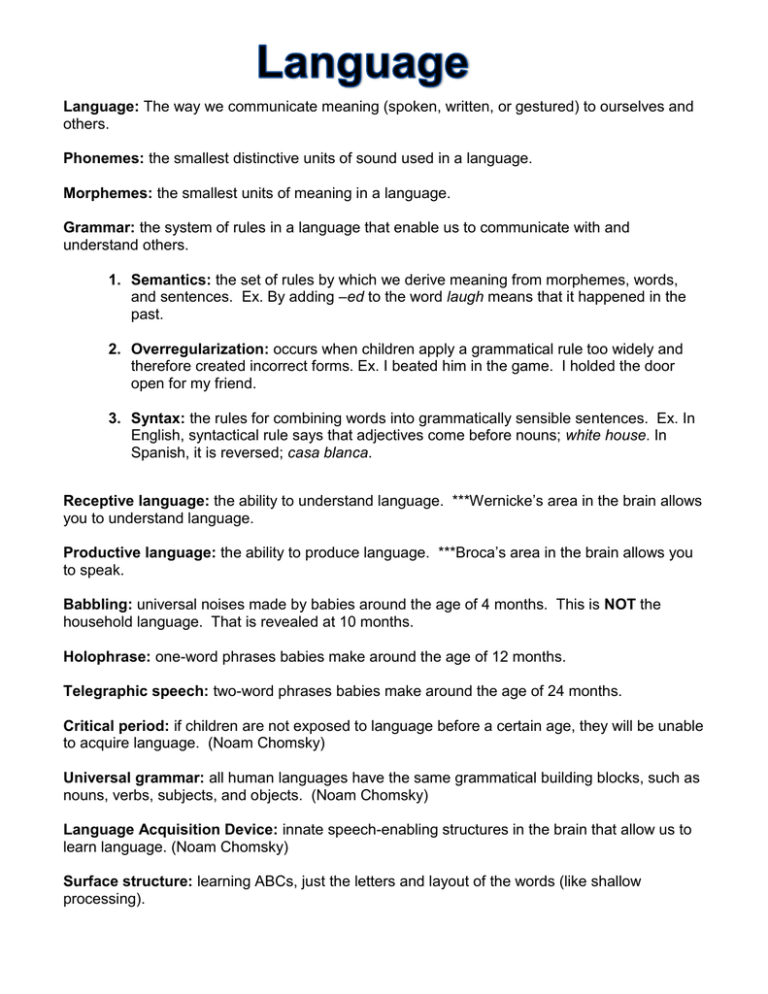
Language: The way we communicate meaning (spoken, written, or gestured) to ourselves and others. Phonemes: the smallest distinctive units of sound used in a language. Morphemes: the smallest units of meaning in a language. Grammar: the system of rules in a language that enable us to communicate with and understand others. 1. Semantics: the set of rules by which we derive meaning from morphemes, words, and sentences. Ex. By adding –ed to the word laugh means that it happened in the past. 2. Overregularization: occurs when children apply a grammatical rule too widely and therefore created incorrect forms. Ex. I beated him in the game. I holded the door open for my friend. 3. Syntax: the rules for combining words into grammatically sensible sentences. Ex. In English, syntactical rule says that adjectives come before nouns; white house. In Spanish, it is reversed; casa blanca. Receptive language: the ability to understand language. ***Wernicke’s area in the brain allows you to understand language. Productive language: the ability to produce language. ***Broca’s area in the brain allows you to speak. Babbling: universal noises made by babies around the age of 4 months. This is NOT the household language. That is revealed at 10 months. Holophrase: one-word phrases babies make around the age of 12 months. Telegraphic speech: two-word phrases babies make around the age of 24 months. Critical period: if children are not exposed to language before a certain age, they will be unable to acquire language. (Noam Chomsky) Universal grammar: all human languages have the same grammatical building blocks, such as nouns, verbs, subjects, and objects. (Noam Chomsky) Language Acquisition Device: innate speech-enabling structures in the brain that allow us to learn language. (Noam Chomsky) Surface structure: learning ABCs, just the letters and layout of the words (like shallow processing). Deep structure: combining words to make meanings (like deep processing). Linguistic determinism: thinking affects our language, which in turn affects our thoughts. (Benjamin Whorf) Language Key People/Animals: B.F. Skinner: argues that language is acquisition is based on the principles of operant conditioning – babies imitate sounds and then are reinforced. ***Nurture point of view. Noam Chomsky: a linguist who argues that young children possess an innate capability to learn and produce speech. Believes that children in widely different cultures progress through the same stages of language development at about the same age. Believes in the language acquisition device. ***Nature point of view. Benjamin Whorf: a linguist who believed that a language does more than describe a person’s culture. He argued that a person’s language may also shape a person’s thoughts and perceptions (linguistic determinism). Sultan: Chimpanzee who demonstrated insight by getting out of reach food with a stick. Koko: Gorilla who could sign over 1,000 words. Called Pinocchio a “baby elephant”. Washoe: Chimpanzee who could sign about 132 words. Gave an interview to a New York Times reporter. Kanzi: Chimpanzee who roasted marshmellows.
